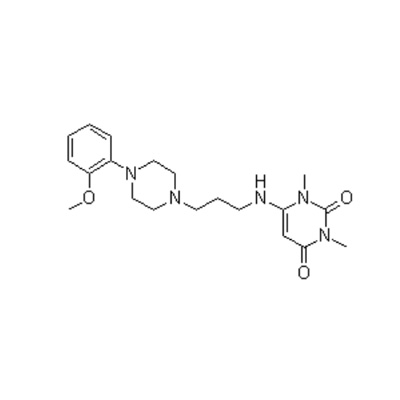
- English
- Español
- Português
- русский
- Français
- 日本語
- Deutsch
- tiếng Việt
- Italiano
- Nederlands
- ภาษาไทย
- Polski
- 한국어
- Svenska
- magyar
- Malay
- বাংলা ভাষার
- Dansk
- Suomi
- हिन्दी
- Pilipino
- Türkçe
- Gaeilge
- العربية
- Indonesia
- Norsk
- تمل
- český
- ελληνικά
- український
- Javanese
- فارسی
- தமிழ்
- తెలుగు
- नेपाली
- Burmese
- български
- ລາວ
- Latine
- Қазақша
- Euskal
- Azərbaycan
- Slovenský jazyk
- Македонски
- Lietuvos
- Eesti Keel
- Română
- Slovenski
- मराठी
- Srpski језик
What is Urapidil Hydrochloride

What are the side effects of Urapidil Hydrochloride?
Some common side effects of Urapidil Hydrochloride include dizziness, headache, nausea, and low blood pressure. In rare cases, it may cause allergic reactions or liver damage. It is important to consult a doctor immediately if any side effects are experienced.How does Urapidil Hydrochloride work?
Urapidil Hydrochloride works by blocking certain receptors in the body, which leads to the dilation of blood vessels and a reduction in blood pressure. It also reduces the activity of the sympathetic nervous system, which plays a role in regulating blood pressure.What are the precautions when using Urapidil Hydrochloride?
Urapidil Hydrochloride should not be used in patients with a history of liver or kidney disease, as well as those with low blood pressure. It should also be used with caution in pregnant or breastfeeding women. In all cases, it is important to consult a doctor before using this medication.In conclusion, Urapidil Hydrochloride is a medication used in the treatment of hypertensive emergencies. It works by dilating blood vessels and reducing blood pressure. While there are some side effects associated with its use, it can be an effective treatment option when used under the supervision of a doctor.
Jiangsu Run'an Pharmaceutical Co. Ltd. is a company that specializes in the production and distribution of pharmaceutical products. With a commitment to quality and safety, the company is dedicated to providing patients with the best possible care. For more information on our products and services, please visit https://www.jsrapharm.com. For any inquiries, please contact us at wangjing@ctqjph.com.
Scientific Research
1. Sasaki, H. et al. (2002). Pharmacokinetics and pharmacodynamics of urapidil infusion in healthy volunteers. Journal of clinical pharmacology, 42(7), 744-752.
2. Krasowski, M.D. & Penrod, L.E. (2006). Clinical applications of urapidil. Journal of clinical hypertension, 8(12), 878-886.
3. Yoshiki, H. et al. (1998). Studies on potent and specific inhibitors for angiotensin-converting enzyme; candidates for cerebral selective vasodilators. Bioorganic & medicinal chemistry, 6(11), 2045-2056.
4. Cacoub, P. et al. (1991). Urapidil in the treatment of arterial hypertension in patients with cirrhosis. Journal of hypertension, 9(4), 331-335.
5. Gavras, H. et al. (1986). Urapidil, an antihypertensive drug acting through alpha-adrenoceptor blockade. Clinical science, 71(3), 313-316.
6. Kleinbloesem, C.H. et al. (1989). Pharmacokinetics and pharmacodynamics of urapidil: a review. Clinical pharmacokinetics, 16(1), 31-47.
7. Burnham, T.H. & Mehta, R. (1993). Urapidil: a review of its pharmacodynamic and pharmacokinetic properties, and clinical use in hypertension. Drugs, 45(6), 909-929.
8. Materson, B.J. et al. (1979). Sodium nitroprusside or urapidil as initial therapy in the treatment of hypertensive emergencies? Archives of internal medicine, 139(7), 753-755.
9. Krämer, S.C. et al. (1995). Acute efficacy and safety of intravenous urapidil in comparison with nitroglycerin in hypertensive emergencies and urgencies. Blood pressure, 4(6), 352-357.
10. Kirch, W. et al. (1990). Urapidil, an interesting drug in hypertensive patients with renal insufficiency. Clinical pharmacology and therapeutics, 48(6), 648-657.


